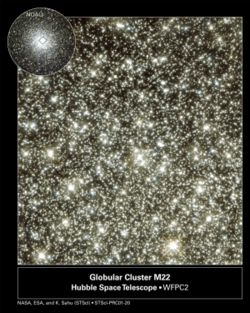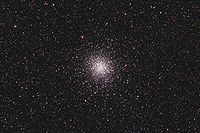- Messier 22
-
Messier 22 
Core of Messier 22Observation data (J2000 epoch) Class VII Constellation Sagittarius Right ascension 18h 36m 24.21s[1] Declination -23° 54′ 12.2″[1] Distance 10.6 ± 1.0 kly (3.3 ± 0.3 kpc[2]) Apparent magnitude (V) +5.1[3] Apparent dimensions (V) 32 arcmins Physical characteristics Mass 105 to 106 M☉ Radius 50 ± 5 ly[4] VHB 14.2 Estimated age 12 Gyr[5] Notable features One of four globulars known
to contain a planetary nebula.Other designations NGC 6656, GCl 99[1] See also: Globular cluster, List of globular clusters  Globular Cluster Messier 22 with amateur telescope
Globular Cluster Messier 22 with amateur telescope
Messier 22 (also known as M22 or NGC 6656) is an elliptical globular cluster in the constellation Sagittarius, near the Galactic bulge region. It is one of the brightest globulars that is visible in the night sky.
Contents
History
M22 was one of the first globulars to be discovered in 1665 by Abraham Ihle[2] and it was included in Charles Messier's catalog of comet-like objects on June 5, 1764.
It was one of the first globular clusters to be carefully studied first by Harlow Shapley in 1930. He discovered roughly 70,000 stars and found it had a dense core.[6] Then Halton Arp and William G. Melbourne continued studies in 1959.[7] Because of the large color spread of its red giant branch (RGB) sequence, which is similar to that observed in Omega Centauri, it became the object of intense scrutiny starting in 1977 with James E. Hesser et al.[2][8]
Characteristics
M22 is one of the nearer globular clusters to Earth at a distance of about 10,600 light-years away. It spans 32' on the sky which translates to a spatial diameter of 99 ± 9 light-years. 32 variable stars have been recorded in M22. It is projected in front of the galactic bulge and is therefore useful for its microlensing effect on the background stars in the bulge.[5]
Despite its relative proximity to us, this metal-poor cluster's light is limited by dust extinction, giving it an apparent magnitude of 5.5 making it the brightest globular cluster visible from mid-northern latitudes (e.g. Europe and most of North America).[9] However, due to its southerly declination, M22 never rises high in the sky and so appears less impressive than other summer sky globulars such as M13 and M5.
Planetary Nebula
M22 is very unusual in that it is one of only four globulars (the others being M15, NGC 6441 and Palomar 6) that are known to contain a planetary nebula. It was discovered using the IRAS satellite by Fred Gillett et al.,in 1986 as a pointlike source (IRAS 18333-2357)[10] and subsequently identified as a planetary nebula in 1989 by Gillett et al.[11] The planetary nebula's central star is a blue star. The planetary nebula (designated GJJC1) is estimated to be a mere ~6,000 years old.[2]
See also
References
- ^ a b c "SIMBAD Astronomical Database". Results for NGC 6656. http://simbad.u-strasbg.fr/Simbad. Retrieved 2006-11-15.
- ^ a b c d Monaco, L.; Pancino, E.; Ferraro, F. R.; Bellazzini, M. (2004). "Wide-field photometry of the Galactic globular cluster M22". Monthly Notices of the Royal Astronomical Society 349 (4): 1278–1290. arXiv:astro-ph/0401392. Bibcode 2004MNRAS.349.1278M. doi:10.1111/j.1365-2966.2004.07599.x.
- ^ Galactic Globular Clusters Database (M22)
- ^ distance × sin( diameter_angle / 2 ) = 50 ly radius
- ^ a b Gaudi, B. Scott (2002). "Interpreting the M22 Spike Events". Astrophysical Journal 566 (1): 452–462. arXiv:astro-ph/0108301. Bibcode 2002ApJ...566..452G. doi:10.1086/338041.
- ^ Shapley, Harlow (1930). "The Mass-Spectrum Relation for Giant Stars in the Globular Cluster Messier 22". Harvard College Observatory Bulletin 874: 4–9. Bibcode 1930BHarO.874....4S.
- ^ Arp, H. C.; Melbourne, W. G. (1959). "Color-magnitude diagram for the globular cluster M22". Astronomical Journal 64: 28. Bibcode 1959AJ.....64...28A. doi:10.1086/107848.
- ^ Hesser, J. E.; Hartwick, F. D. A.; McClure, R. D. (1977). "Cyanogen strengths and ultraviolet excesses of evolved stars in 17 globular clusters from DDO photometry". Astrophysical Journal Supplement Series 33: 471. Bibcode 1977ApJS...33..471H. doi:10.1086/190438.
- ^ I. Ivans, C. Sneden, G. Wallerstein, R. P. Kraft, J. E. Norris, J. P. Fulbright, and G. Gonzalez (2004). "On the Question of a Metallicity Spread in Globular Cluster M22 (NGC 6656)". Memorie della Società Astronomica Italiana 75: 286. Bibcode 2004MmSAI..75..286I.
- ^ Gillett, F. C.; Neugebauer, G.; Emerson, J. P.; Rice, W. L. (1986). "IRAS 18333-2357 - an unusual source in M22". Astrophysical Journal 300: 722–728. Bibcode 1986ApJ...300..722G. doi:10.1086/163846.
- ^ Cohen, J. G.; Gillett, F. C. (1989). "The peculiar planetary nebula in M22". Astrophysical Journal 346: 803–807. Bibcode 1989ApJ...346..803C. doi:10.1086/168061.
External links
- Messier 22, SEDS Messier pages
- Messier 22, Galactic Globular Clusters Database page
- Messier 22 on WikiSky: DSS2, SDSS, GALEX, IRAS, Hydrogen α, X-Ray, Astrophoto, Sky Map, Articles and images
Coordinates:
 18h 36m 24.21s, −23° 54′ 12.2″
18h 36m 24.21s, −23° 54′ 12.2″Messier objects List M1 · M2 · M3 · M4 · M5 · M6 · M7 · M8 · M9 · M10 · M11 · M12 · M13 · M14 · M15 · M16 · M17 · M18 · M19 · M20 · M21 · M22 · M23 · M24 · M25 · M26 · M27 · M28 · M29 · M30 · M31 · M32 · M33 · M34 · M35 · M36 · M37 · M38 · M39 · M40 · M41 · M42 · M43 · M44 · M45 · M46 · M47 · M48 · M49 · M50 · M51 · M52 · M53 · M54 · M55 · M56 · M57 · M58 · M59 · M60 · M61 · M62 · M63 · M64 · M65 · M66 · M67 · M68 · M69 · M70 · M71 · M72 · M73 · M74 · M75 · M76 · M77 · M78 · M79 · M80 · M81 · M82 · M83 · M84 · M85 · M86 · M87 · M88 · M89 · M90 · M91 · M92 · M93 · M94 · M95 · M96 · M97 · M98 · M99 · M100 · M101 · M102 · M103 · M104 · M105 · M106 · M107 · M108 · M109 · M110See also  Book:Messier objects ·
Book:Messier objects ·  Category:Messier objects
Category:Messier objects  Portal:AstronomyCategories:
Portal:AstronomyCategories:- Globular clusters
- Sagittarius constellation
- Messier objects
- NGC objects
Wikimedia Foundation. 2010.
